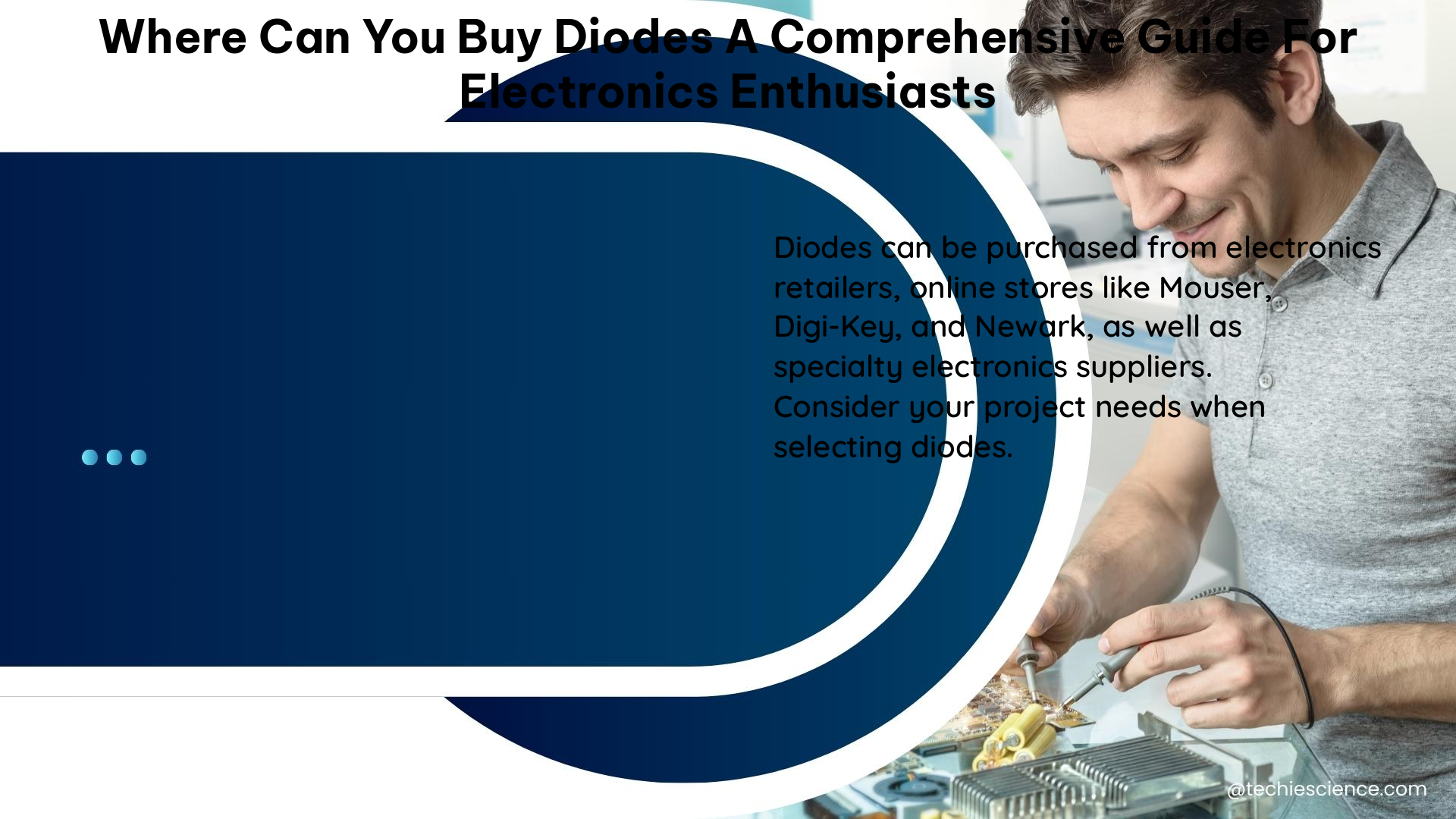As an electronics enthusiast or technical student, finding the right diodes for your projects can be a crucial task. Diodes are fundamental components in electronic circuits, serving various functions such as rectification, voltage regulation, and signal conditioning. This comprehensive guide will provide you with advanced hands-on details and technical specifications to help you make an informed decision when purchasing diodes.
Types of Diodes
- Standard Rectifiers: These are the most common type of diodes used for converting AC to DC. They have a high forward voltage drop, typically around 0.6-0.7 V, and are not suitable for high-frequency applications due to their relatively slow switching speed.
- Fast Rectifiers: These diodes have a lower forward voltage drop, usually around 0.4-0.5 V, and are faster than standard rectifiers, making them suitable for high-frequency applications. They are often used in switch-mode power supplies and other high-speed circuits.
- Schottky Diodes: These diodes have an extremely low forward voltage drop, typically around 0.2-0.4 V, and are extremely fast, with a reverse recovery time in the range of a few nanoseconds. Schottky diodes are ideal for high-frequency applications, such as in RF circuits and high-speed switching.
- Zener Diodes: These diodes are designed to operate in the reverse-bias region and are used for voltage regulation. They maintain a constant voltage drop across their terminals, even with varying current, making them useful for stabilizing voltage levels in electronic circuits.
- Tuning/Varactor Diodes: These diodes are used for electronic tuning in radio and TV receivers. They have a variable capacitance that changes with the applied reverse voltage, allowing for precise control of the tuning frequency.
- Programmable Diodes: These diodes can be programmed to have specific characteristics, making them useful in a wide range of applications, such as voltage regulation, signal conditioning, and even memory storage.
Where to Buy Diodes

-
Future Electronics: Future Electronics is a leading global distributor of electronic components, including a vast selection of diodes. They offer diodes from various manufacturers, and you can filter your search results based on parameters such as maximum reverse recovery time, maximum reverse current, maximum average rectified current, forward voltage, maximum reverse voltage, power dissipation, maximum average forward current, maximum peak current, and packaging type. Future Electronics also provides diodes in production-ready packaging or R&D quantities.
-
Amazon: Amazon is a popular online marketplace that offers a wide range of diodes for beginners and hobbyists. You can find diodes in kits or individually, depending on your needs. For example, the Joe Knows Electronics Semiconductor Kit contains 320 transistors and diodes, including Schottky diodes, making it a great option for electronics enthusiasts looking to build a comprehensive component collection.
-
Local Electronics Stores or Hobby Shops: If you prefer to purchase diodes from a physical store, you can visit local electronics stores or hobby shops that cater to electronics enthusiasts. These stores may carry a selection of electronic components, including diodes, for working on small complex circuits. However, the availability of specific components like diodes may vary depending on the store’s inventory.
Theorem and Electronics Formula
The Shockley diode equation, also known as the diode law, describes the relationship between the current flowing through a diode and the voltage across it:
I = I_S(e^(V_D/nV_T) – 1)
Where:
– I is the diode current
– I_S is the saturation current
– V_D is the voltage across the diode
– n is the ideality factor
– V_T is the thermal voltage
This equation is fundamental in understanding the behavior of diodes and their applications in electronic circuits.
Electronics Examples and Numerical Problems
Example: A diode has a saturation current of 10^-12 A and a forward voltage drop of 0.7 V. Calculate the current flowing through the diode when a voltage of 1 V is applied.
Solution:
Using the Shockley diode equation:
I = I_S(e^(V_D/nV_T) – 1)
I = 10^-12(e^(1/0.0258) – 1)
I = 10^-12(e^38.68 – 1)
I = 10^-12(6.8 x 10^16 – 1)
I = 6.8 x 10^-6 A
Therefore, the current flowing through the diode is 6.8 mA.
Figures, Data Points, Values, and Measurements
When selecting diodes for your projects, it is important to consider the following parameters:
-
Maximum Forward Current: The maximum current that can flow through the diode without causing damage. This parameter is typically specified in amperes (A) or milliamperes (mA).
-
Maximum Reverse Voltage: The maximum voltage that can be applied to the diode in the reverse-bias direction without causing damage. This parameter is typically specified in volts (V).
-
Forward Voltage Drop: The voltage drop across the diode when it is conducting current in the forward direction. This parameter is typically specified in volts (V).
-
Maximum Power Dissipation: The maximum power that the diode can dissipate without causing damage. This parameter is typically specified in watts (W).
-
Reverse Recovery Time: The time it takes for the diode to switch from conducting to blocking current in the reverse-bias direction. This parameter is typically specified in nanoseconds (ns) or microseconds (μs).
By considering these parameters, you can select the appropriate diodes for your specific application and ensure the reliable operation of your electronic circuits.
References
- What Diodes Should I Buy?
- Diodes at Future Electronics
- Electronic Components for Beginners: Fundamentals of Transistors and Diodes
- Joe Knows Electronics Semiconductor Kit
- Where to Buy Electronics Supplies Like Diodes

The lambdageeks.com Core SME Team is a group of experienced subject matter experts from diverse scientific and technical fields including Physics, Chemistry, Technology,Electronics & Electrical Engineering, Automotive, Mechanical Engineering. Our team collaborates to create high-quality, well-researched articles on a wide range of science and technology topics for the lambdageeks.com website.
All Our Senior SME are having more than 7 Years of experience in the respective fields . They are either Working Industry Professionals or assocaited With different Universities. Refer Our Authors Page to get to know About our Core SMEs.